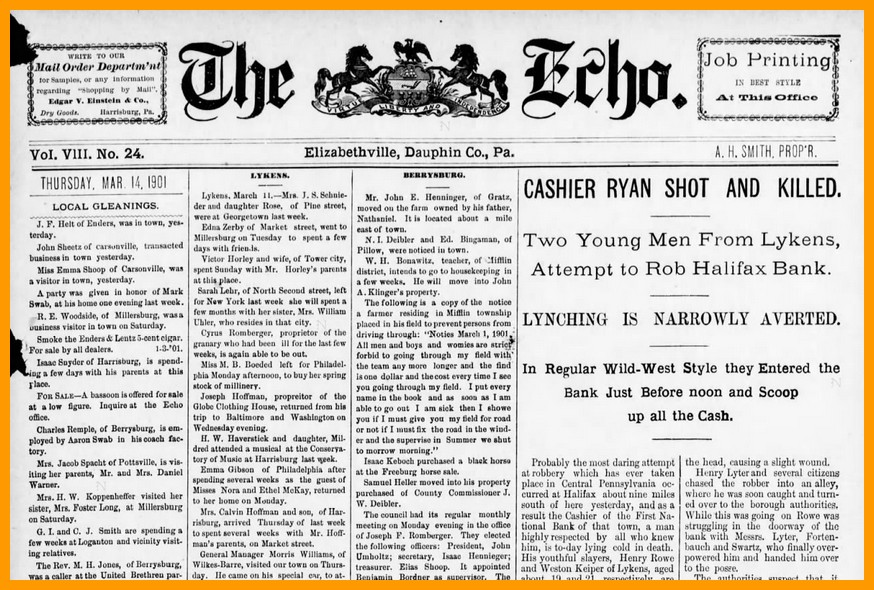The Elizabethville Echo of Elizabethville, Dauphin County, Pennsylvania, did not normally use such large, bold-faced print in its headlines. But the weekly edition of the newspaper was compelled in its 14 March 1901 edition to report on a significant event that occurred just a few miles from the borough, and which included the hiring of and use of a carriage from Cook’s Livery, located in the borough. Indeed, the robbers traveled to Elizabethville from their home base in Lykens, picked up the carriage at Cook’s Livery, and then traveled over Berry’s Mountain to Halifax, at which place they committed their crime, which resulted in the death of the cashier of the Halifax Bank and the capture of two of the robbers at the scene of the crime.
The Halifax Bank Robbery has been extensively discussed on The Civil War Blog, and those who wish to follow it in further detail can access those blog post by clicking here.
The following is the text of the article that appeared in the Elizabethville Echo:
CASHIER RYAN SHOT AND KILLED
Two Young Men From Lykens, Attempt to Rob Halifax Bank
LYNCHING IS NARROWLY AVERTED
In Regular Wild-West Style they Entered the Bank Just Before noon and Scoop up all the Cash
Probably the most daring attempt at robbery which has ever taken place in Central Pennsylvania occurred at Halifax about nine miles south of here yesterday, and as a result the Cashier of the First National Bank of that town, a man highly respected by all who knew him, is to-day lying cold in death. His youthful slayers, Henry Rowe and Weston Keiper of Lykens, aged about 19 and 21 respectively, are confined in the county jail at Harrisburg, and will probably be tried at next week’s term of court, with absolutely no hope of being able to clear themselves.
The bullet which caused Cashier Ryan’s death struck him below the bend of the leg and glanced upward on the bone, passing through the bowels and causing hemorrages [sic] which ended with the death of the plucky man five hours after shooting. Mr. Ryan was conscious to the last, but made no statement as to which of the men shot him.
He was one of the best known residents of Halifax and was one of the board of prison inspectors, having been appointed in 1894. He is survived by a wife and two sons.
PLANNED SOME TIME BACK
It appears the robbery was planned some time ago, as a carriage had been engaged at Cook’s Livery, at this place [Elizabethville], already last Monday, for the purpose of driving to Halifax, and the two men were seen loitering about the bank building at Halifax fully three weeks ago.
The pair were driven to this place this (Thursday) morning by a man named “Sikesey” Sholey, who has also been arrested on suspicion of being an accomplice. Sholey drove to the top of the mountain south of town with Keiper and Rowe, stopping off at the livery procured his team and followed them. At the top of the mountain he met his associateS, and taking Keiper with him drove to Halifax, Sholey returning to Lykens with the carriage.
Arriving at Halifax about 11:15 o’clock, this forenoon, the two young desperados immediately entered the bank, one of them covering the cashier with two revolvers, while the other entered the directors’ room and took charge of the teller, Mr. Lyter; the president, A. Fortenbauch; and Representative William Schwartz, who were occupying that room at the time.
The cashier was ordered to open the safe, and he quickly obeyed, and all the cash of the bank was soon scooped into a large satchel. What was left over Rowe thrust into his pockets.
In an unlucky moment for Rowe he laid one of his revolvers upon a table , and the cashier quickly sprang upon him. A tussle ensued and a number of shots were exchanged, one of which proved fatal to Mr. Ryan.
A crowd of citizens was attracted by the shooting and quickly gathered in front of the bank. Keiper ran out into the street. He was followed by Rowe, who was stopped in the doorway by Teller Lyter. Henry Lyter, who conducts a store adjoining the bank, picked up a shotgun from behind his counter and ran into the street, firing two shots at Keiper. One hit him in the back of the head, causing a slight wound.
Henry Lyter and several citizens chased the robber into an alley, where he was soon caught and turned over to the borough authorities. While this was going on Rowe was struggling in the doorway of the bank with Messrs. Lyter, Fortenbauch, and Swartz, who finally overpowered him and handed him over to the posse.
The authorities suspect that it was the intention of the robbers to break into the bank at night in the event of the failure of their plot to commit the crime in daylight. The satchel which Rowe dropped had a dynamite fuse in it with which to blow open the safe.
_____________________________
Corrections and additional information should be added as comments to this post.
